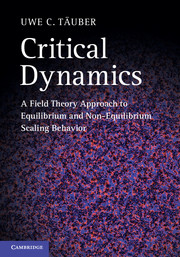Book contents
- Frontmatter
- Dedication
- Contents
- Preface
- Part I Near-equilibrium critical dynamics
- 1 Equilibrium critical phenomena
- 2 Stochastic dynamics
- 3 Dynamic scaling
- 4 Dynamic perturbation theory
- 5 Dynamic renormalization group
- 6 Hydrodynamic modes and reversible mode couplings
- 7 Phase transitions in quantum systems
- Part II Scale invariance in non-equilibrium systems
- Index
- References
3 - Dynamic scaling
from Part I - Near-equilibrium critical dynamics
Published online by Cambridge University Press: 05 June 2014
- Frontmatter
- Dedication
- Contents
- Preface
- Part I Near-equilibrium critical dynamics
- 1 Equilibrium critical phenomena
- 2 Stochastic dynamics
- 3 Dynamic scaling
- 4 Dynamic perturbation theory
- 5 Dynamic renormalization group
- 6 Hydrodynamic modes and reversible mode couplings
- 7 Phase transitions in quantum systems
- Part II Scale invariance in non-equilibrium systems
- Index
- References
Summary
In the preceding chapter, we have introduced several levels for the mathematical description of stochastic dynamics. We now use the kinetic Ising models introduced in Section 2.3.3 to formulate the dynamic scaling hypothesis which appropriately generalizes the homogeneity property of the static correlation function in the vicinity of a critical point, as established in Chapter 1. The dynamic critical exponent z is defined to characterize both the critical dispersion and the basic phenomenon of critical slowing-down. As a next step, and building on the results of Section 2.4, a continuum effective theory for the mesoscopic order parameter density, basically the dynamical analog to the Ginzburg–Landau approach, is constructed in terms of a non-linear Langevin equation. The distinction between dissipative and diffusive dynamics for the purely relaxational kinetics of either a non-conserved or conserved order parameter field, respectively, defines the universality classes A and B. Following the analysis of these models in the Gaussian approximation, they also serve to outline the construction of a dynamical perturbation theory for non-linear stochastic differential equations through direct iteration. In general, however, the order parameter alone does not suffice to fully capture the critical dynamics near a second-order phase transition. Additional hydrodynamic modes originating from conservation laws need to be accounted for as well. The simplest such situation is entailed in the relaxational models C and D, which encompass the static coupling of the order parameter to the energy density. Further scenarios emerge through reversible non-linear mode couplings in the Langevin equations of motion.
- Type
- Chapter
- Information
- Critical DynamicsA Field Theory Approach to Equilibrium and Non-Equilibrium Scaling Behavior, pp. 96 - 129Publisher: Cambridge University PressPrint publication year: 2014

